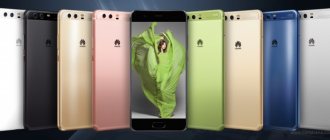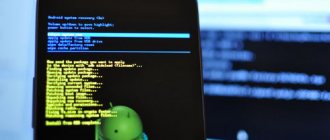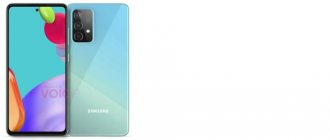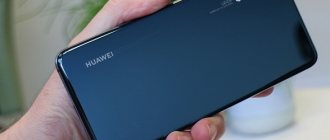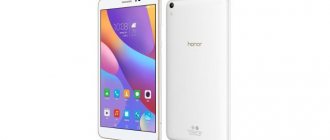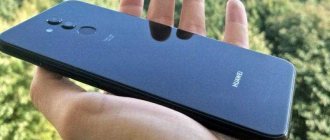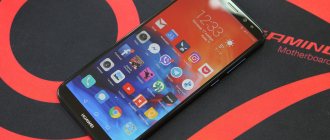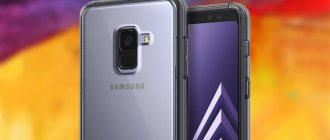Huawei Mate 8 is a stylish smartpad for the business segment. This is indicated by both the technical characteristics and design of this device, as well as the dimensions of its 6-inch screen. This gadget was presented to the general public at CES 2015. It replaced the previous iteration of smartphones. According to the Chinese developers, they did not plan to redesign the appearance of the device. This, rather, can be called a kind of work on bugs and updating the successful Huawei Mate 7.
What the 8th Mate model can please you with, this Huawei Mate 8 review will tell you about it.
Specifications
Before starting a detailed review of the Huawei Mate 8, let's briefly take a look at the technical characteristics of this device:
| Weight | 186 g; |
| Dimensions | 7.9×80.6×157.1 mm; |
| Battery capacity | 4000 mAh, non-removable type; |
| RAM capacity | 3 Gb; |
| Internal memory capacity | 32 Gb; |
| Screen | 6-inch, 368 ppi, 1080×1920; |
| Cameras | main - 16-megapixel (with autofocus and flash), front - 8-megapixel; |
| Sensors | fingerprint scanner, microscope, compass, barometer, proximity and light sensors; |
| Navigation | Glonass, GPS; |
| Wireless interfaces | NFC, bluetooth 4.2, Wi-Fi Direct and 802.11 ac/n/g/b/a; |
| SIM cards | 2 nano-SIM cards; |
| Connection | LTE 1, 3, 7, 20 || UMTS 2100/1900/900/850 MHz || GSM 1900/1800/900/850 MHz; |
| Supported memory cards | micro SDXC up to 128 Gb; |
| Graphics accelerator | Mali-T880 MP4; |
| Chipset | 8-core Huawei Kirin 950, 2.3 GHz; |
| OS | Android 6.0 + EMUI 4.0. |
⇡#Technical characteristics
| Huawei Mate 8 | Huawei Mate S | Samsung GALAXY Note 5 | Google Nexus 6P | LG V10 | |
| Display | 6 inches, IPS, 1920 × 1080 pixels, 368 ppi, capacitive multi-touch | 5.5 inches, AMOLED, 1920 × 1080 pixels, 401 ppi, capacitive multi-touch | 5.7 inches, AMOLED, 2560 × 1440 pixels, 515 ppi, capacitive multi-touch, S Pen stylus support | 5.7 inches, AMOLED, 2560 × 1440 pixels, 515 ppi, capacitive multi-touch | 5.7 inches, 2560 × 1440, IPS, 515 ppi, capacitive multi-touch |
| Additional display | No | No | No | No | 2.09 inches, 1040 × 160 pixels, IPS; Gesture support |
| Air gap | No | No | No | No | No |
| Protective glass | Corning Gorilla Glass 4 | Corning Gorilla Glass 4 | Corning Gorilla Glass 4 on both sides | Corning Gorilla Glass 4 | Corning Gorilla Glass 3 |
| CPU | HiSilicon Kirin 950 (four ARM Cortex-A72 cores, 2.3 GHz; four ARM Cortex-A53 cores, 1.8 GHz) + IntelliSense i5 coprocessor | HiSilicon Kirin 935 (four ARM Cortex-A53 cores, 1.5 GHz; four ARM Cortex-A53e cores, 2.2 GHz) | Samsung Exynos 7420 (four ARM Cortex-A57 cores, 2.1 GHz; four ARM Cortex-A53 cores, 1.5 GHz) | Qualcomm Snapdragon 810 (four ARM Cortex-A53 cores, 1.55 GHz + two ARM Cortex-A57 cores, 2 GHz) | Qualcomm Snapdragon 808 (four ARM Cortex-A53 cores, 1.4 GHz + two ARM Cortex-A57 cores, 1.82 GHz) |
| Graphics controller | Mali-T880 MP4 | Mali-T628MP4 | Mali-T760 MP8 | Adreno 430 | Adreno 418 |
| RAM | 3/4 GB | 3 GB | 4 GB | 3 GB | 4 GB |
| Flash memory | 32/64 GB | 32/64/128 GB | 32/64 GB | 32/64/128 GB | 64 GB |
| Memory card support | There is | There is | No | No | There is |
| Connectors | microUSB, mini-jack 3.5 mm | microUSB, mini-jack 3.5 mm | microUSB, mini-jack 3.5 mm | USB-C, 3.5 mm minijack | microUSB, 3.5 mm minijack |
| SIM cards | two nanoSIM | two nanoSIM | one nanoSIM | one nanoSIM | two nanoSIM |
| Cellular connection 2G | GSM 850 / 900 / 1800 / 1900 MHz | GSM 850 / 900 / 1800 / 1900 MHz | GSM 850 / 900 / 1800 / 1900 MHz | GSM 850 / 900 / 1800 / 1900 MHz | GSM 850 / 900 / 1800 / 1900 MHz |
| Cellular 3G | UMTS 800/850/900/1900/2100 MHz | UMTS 850/900/1900/2100 MHz | HSPA 850/900/1900/2100 MHz | HSDPA 850/900/1700/1800/1900/2100 MHz | HDSPA 850/900/1900/2100 MHz |
| Cellular 4G | FDD LTE Cat. 6 (up to 300 Mbit/s): bands 1, 2, 3, 4, 5, 6, 7, 8, 12, 17, 19, 20, 26, 38, 39, 40 | FDD LTE Cat. 4 (up to 150 Mbit/s): bands 1, 2, 3, 4, 5, 7, 8, 17, 20, 38, 39, 40, 41 | FDD LTE Cat. 9 (up to 450/50 Mbit/s): bands 1, 2, 3, 4, 5, 7, 8, 12, 17, 18, 19, 20, 26 | LTE Cat. 6 (up to 300 Mbit/s): bands 1, 2, 3, 4, 5, 7, 8, 9, 17, 19, 20, 28, 38, 39, 40, 41 | LTE Cat. 4 (up to 150 Mbit/s), bands 1, 3, 7 |
| WiFi | 802.11a/b/g/n/ac | 802.11b/g/n | 802.11a/b/g/n/ac | 802.11a/b/g/n/ac | 802.11a/b/g/n/ac |
| Bluetooth | 4.2 | 4.0 | 4.2 | 4.2 | 4.1 |
| NFC | There is | There is | There is | There is | There is |
| IR port | No | No | No | No | There is |
| Navigation | GPS, A-GPS, GLONASS, BeiDou | GPS, A-GPS, GLONASS (BeiDou for the Chinese market) | GPS, A-GPS, GLONASS, BeiDou | GPS, A-GPS, GLONASS, BeiDou | GPS, A-GPS, GLONASS, BeiDou |
| Sensors | Illumination, proximity, accelerometer/gyroscope, magnetometer (digital compass), barometer | Illumination, proximity, accelerometer/gyroscope, magnetometer (digital compass) | Illumination, proximity, accelerometer, barometer, magnetometer (digital compass), heart rate sensor | Illumination, proximity, accelerometer/gyroscope, magnetometer (digital compass), pedometer | |
| Light, proximity sensor, pressure sensor, accelerometer/gyroscope, magnetometer (digital compass), pedometer | |||||
| Fingerprint's scanner | There is | There is | There is | There is | There is |
| Main camera | 16 MP, ƒ/2.0, autofocus, optical stabilization, LED flash, Full HD video recording | 13 MP, ƒ/2.0, autofocus, optical stabilization, LED flash, Full HD video recording | 16 MP, ƒ/1.9, laser autofocus, LED flash, optical stabilization, 4K video recording | 12.3 MP, ƒ/2.0, laser autofocus, LED flash, 4K video recording | 16 MP, ƒ/1.8, laser autofocus, LED flash, optical stabilization, Full HD video recording |
| Front-camera | 8 MP, fixed focus | 8 MP, fixed focus | 5 MP, fixed focus | 8 MP, fixed focus | 5 MP, fixed focus, 80° viewing angle + 5 MP, fixed focus, 120° viewing angle |
| Nutrition | Non-removable 15.2 Wh battery (4000 mAh, 3.8 V) | Non-removable 10.26 Wh battery (2700 mAh, 3.8 V) | Removable 11.4 Wh battery (3000 mAh, 3.8 V) | Non-removable 13.11 Wh battery (3450 mAh, 3.8 V) | Removable 11.4 Wh battery (3000 mAh, 3.8 V) |
| Size | 157.1 × 80.6 × 7.9 mm | 137 × 72 × 9.8 mm | 153 × 76 × 7.6 mm | 159.3 × 77.8 × 7.3 mm | 160 × 80 × 8.6 mm |
| Weight | 185 grams | 156 grams | 171 grams | 178 grams | 192 grams |
| Housing protection | No | No | No | No | No |
| operating system | Android 6.0 Marshmallow, own EMUI 4.0 shell | Android 5.1 Lolliipop, own EMUI 3.1 shell | Android 5.1 Lolliipop, Samsung's own TouchWiz shell | Android 6.0 Marshmallow | Android 5.1 Lolliipop |
| Current price | 600-700 euros (not yet sold in Russia) | 41,000 rubles (for version with 64 GB of memory) | 44,000-49,000 rubles (depending on memory capacity) | 49,990-56,990 rubles (depending on memory capacity) | 50,990 rubles |
| Huawei Mate 8 – information about the filling according to the CPU-Z application | ||
Equipment
Huawei Mate 8 is sold in a beautiful black cardboard box, the front of which is decorated with the model name printed in gold letters.
Everything in the box is stacked in layers. On top there is a special box for the Huawei Mate 8 itself. Below it there are 3 boxes with accessories. The smartpad is equipped with a bumper that can be used to protect the ends, a set of documents, a clip for removing the nano-SIM tray, a stereo headset, a power adapter with a current of up to 2 A, and a USB cable.
Design
A review of the Huawei Mate 8 smartphone is impossible without a detailed consideration of the device’s design. The device has a truly flagship design: 100% metal body, small-sized, for a 6-inch display. The case is only 7.9 millimeters thick, its matte surface created by sandblasting.
The flat sides of the smartphone have the texture of rolled metal. The edges are decorated with shiny chamfers. Strict headbands look very stylish and noble. The phone is available in brown, black and silver colors. The build quality of the case is almost perfect; it does not deform and does not produce any sounds during various manipulations.
The front of Huawei Mate 8 is covered with 2.5D high-strength protective glass. The display occupies 86% of the front part. The fields below and above are decorated with a subtle pattern in the form of funny circles, which can only be seen from a certain angle and only in extremely bright lighting. On the field below there is a manufacturer's logo, above which there are virtual control keys.
In the center above the smartphone display there is a speaker, to the right of which you can see the front camera lens, as well as light level sensors.
The back cover of Huawei Mate 8 is made of aluminum and is non-removable. It has perfectly fitted plastic inserts of the same color as the body of the device.
At the top center of the back panel you can see the main camera, housed in an aluminum disc with a shiny edge. On the left there is a dual LED flash, under which there is a fingerprint sensor with a shiny bevel.
The right side of the smartphone is equipped with a power button and a volume rocker.
The left side is equipped with a clamp-openable tray for 2 nano-SIM cards.
At the top end of Huawei Mate 8 there is a 3.5 mm audio output and a hole for a microphone.
In the central part of the bottom end there is a micro-USB port, on either side of which a pair of grilles are symmetrically located, under which there are microphones and an audio speaker.
There is also a standard decoration for Huawei smartphones - a pair of star screws.
Appearance
The smartphone itself fascinates with its design: the metal body is made in white, small plastic inserts do not spoil the look at all and fit organically. Minimum frills.
The edging of the case is made of polished silver metal.
Almost the entire front side is occupied by a 6-inch screen covered with protective glass. Below it is a small, laconic Huawei inscription. On top there is a speaker, a front camera lens and a light indicator.
In the center of the rear panel is the main camera lens, framed by a wide metal frame, under which there is a fingerprint scanner. The LED flash is located to the left of the camera.
At the very bottom there is a small company logo.
The combined slot for two SIM cards or a SIM card and a microSD card fits so succinctly into the left side that it is barely noticeable.
The volume key and power button are located on the right side. All physical buttons are made of metal and can be easily felt.
The microphone and audio jack are located at the top end. At the bottom there is a microUSB output and two grilles for one speaker - a move that Huawei quite often resorts to, rather for an aesthetic appearance.
Display
Mate 8 received a 6-inch IPS matrix with FullHD resolution (1080x1920). The pixel density level is 368 pixels per 1 inch. Compared to competitors' devices, in which this figure exceeds 500, Huawei Mate 8 looks rather weak, but it is not the numbers that should be assessed, but the quality of the screen itself. It is impossible to see any jagged or pixelated fonts here without a magnifying glass. This is not the most correct technique in terms of image, but in terms of ease of use everything is excellent.
The capacitive touch surface of Huawei Mate 8 is capable of recognizing 10 simultaneous touches. You can use the device with gloves, although without much convenience, but, in any case, you will be able to accept or reject a call.
The maximum screen brightness is 490 cd/m2, and the lowest brightness is 49 cd/m2. Due to the absence of a special air gap and the presence of a polarizing filter, the user can comfortably use the device even in bright light.
The lowest black field level is 0.33 cd/m2, which is quite good for an LCD screen. The contrast level is also at a decent level - 1310:1. The use of LCD, rather than the more modern AMOLED, has led to the fact that the contrast image quality is more pleasing than the huge resolution, but on a small screen.
The color situation on the Huawei Mate 8 screen is so-so. Gamma reaches a value of 2.11, which is not fatal against the standard of 2.2. But the average DeltaE deviation of 5.37 is not encouraging. This deviation is explained by the fact that the color gamut significantly exceeds sRGB standards.
The color temperature of the Huawei Mate 8 screen is 7500K, which is “colder” than the norm of 6500K. This is not critical, since in the settings you can easily switch color profiles, adjusting them to your liking.
Excellent viewing angles are made in the best traditions of IPS: even with a significant deviation from the perpendicular, color distortion does not occur, and the contrast drops slightly.
Huawei Mate 8 - Battery, speakers and call quality
A powerful battery with a capacity of 4000 mAh is hidden inside the large metal case. This capacity is quite impressive, especially considering that a lot of energy is saved by running a display at 1080p resolution rather than QHD.
So Huawei Mate 8 is able to provide battery life that exceeds that of many of its competitive phablets. When using the device all day under normal conditions - working with email, messages, making calls until midnight, we had 49% of the battery left, and thanks to the Doze function in Android Marshmallow, it only discharges 3-5% overnight.
Watching an hour of video drains your smartphone by 8%, but watching an hour of streaming video reduces battery charge by 11%.
Unlike the Nexus 6P, Huawei decided to go against the decision to replace the more commonly used microUSB port with USB-Type C. This is fine at the moment, but competitors are actively equipping new smartphone models with USB-Type C, so in the future the Huawei Mate 8 may not be competitive .
As you might expect, the smartphone does not support wireless charging, but fast charging is possible. Thanks to it, you can charge a completely discharged battery up to 50% in 40 minutes. The battery can be fully charged in 80-90 minutes.
The smartphone does not have front speakers; the sound coming out of the bottom speaker is rather flat. However, adding front-facing speakers would seem to make the smartphone too tall. It is also worth noting the sound recording application, which uses several microphones located around the perimeter of the smartphone. Call quality is also high, especially if you use speakerphone.
Sound
Despite a pair of decorative grilles located on the lower end of the Huawei Mate 8, underneath there is only one speaker, the maximum volume of which is not amazing. The microphone coverage angle is 125°, which is extremely important for hands-free communication.
There is an option for DTS audio enhancement in the headphone settings. The sound quality in the headphones is good. The Music app can play FLAC files.
You can listen to the radio through an FM tuner, for the operation of which you must connect a wired headset that functions as a short-wave antenna. The presence of 3 microphones allows you to record high-quality sound using a voice recorder with a highly effective noise suppression system in the “Interview” and “Meeting” special modes.
Cameras
The main camera of the Huawei Mate 8 uses a 16-megapixel Sony IMX298 sensor, the maximum lens aperture of which is f/2.0. The LED dual photoflash is capable of illuminating the subject in continuous and pulsed modes.
With the vertical orientation of the Huawei Mate 8, on the main screen at the top you can see icons for setting up the flash, going to the menu for switching modes and changing cameras (main/front).
There are 5 links to special shooting modes in a line along the bottom edge:
- "Time period";
- "Video mode";
- "Photo mode";
- "Decoration";
- "Light".
Switching between these modes is carried out by horizontal movement across the surface of the screen. Below the line there are icons for calling up a menu of various special effects filters and going to the gallery, as well as a shutter key.
There are 9 items in the special shooting modes menu:
- "Text recognition";
- "Audio notes";
- "Slowdown";
- "Water marks";
- "Autofocus";
- HDR;
- Pre-mode;
- "Night Shot";
- Panoramic special mode.
Default mode involves a manual option for setting photographic parameters, which are displayed in the form of icons arranged in an arc. Using another similar scale, parameters are selected for making adjustments, which include: white balance, type of focusing, exposure compensation, shutter speed, ISO sensitivity level. If necessary, this scale can be easily collapsed by touching the arrow.
Using the video and photo shooting parameters in the main menu, you can only adjust the frame proportions and resolution. Other points are related to all sorts of auxiliary capabilities for autofocus, the use of on-screen and physical keys.
The Huawei Mate 8 camera can take excellent photos in auto mode in good lighting. You can also get good shots with night photography. In the most difficult conditions, for highly efficient shooting, it is best to use the free mode. In a special mode called “Light”, for high-quality shooting you should use special accessories - a tripod and a clamp.
The main camera is capable of shooting panoramas at high resolution and perfectly coordinates the exposure option for individual frames. But this program is not capable of removing all kinds of rapidly moving objects from the middle and foreground.
In the special “Focus” mode, you can take photographs in a special, original, special format. This is a stack consisting of several photos, which allows you to enable correction of the shooting distance and record images in separate files while working with captured photographic material.
The front camera is equipped with an 8-megapixel sensor and a lens with a strictly fixed photo focus without a flash. Its aperture is f/2.4. It does an excellent job of photographing self-portraits, producing high-quality, clear photographs with competent color rendition in daylight.
Operating system and interface
The device runs Android 6.0 with the proprietary EMUI 4.0 shell.
The latter has modified the familiar Android interface beyond recognition, which may delight some and displease others.
As usual, I’ll briefly tell you a little about the shell. One of the special features in the new version is, for example, the ability to take a “long” screenshot. When you hold down the power key and volume down, you will notice a menu in which you can scroll and take a screenshot as much as you need (for example, a screenshot of several pictures on Instagram or posts on Twitter).
A very simple power manager will tell you not only about the charge level of the smartphone, but also how many hours/minutes are left, tell you how you can “optimize” the power supply and suggest power consumption modes. At the same time, it will not lie and will show real figures of the remaining operating time based on the recent usage history.
Well, a nice change of beautiful lock screen wallpaper - aesthetically pleasing and unobtrusive, but always very, very beautiful.
There are pre-installed applications - Yandex, Opera, Odnoklassniki and Mail.ru Mail.
Memory and memory card
The smartphone is offered in two versions: with 4 GB of RAM and 64 GB of internal memory and with 3 GB of RAM and 32 GB of internal memory.
We are reviewing Huawei Mate 8 with 32 GB and 3 GB RAM. Of the 32 GB of internal memory, no more than 24 GB are available to the user. It should be recalled that the Mate 7 tested at one time had only 16 Gb. The memory of the Mate 8 can be increased by inserting a 128 GB micro SD/XC/HC memory card instead of the second SIM card (the previous model was limited to 64 GB). In addition, support for special USB-OTG technology makes it possible to connect a flash drive.
Huawei Mate 8 results in AnTutu Benchmark
In the popular AnTuTu benchmark, the Huawei Mate 8 smartphone scores an average of about 92,774 points. This figure, like all those given below, was taken from the official website of the developer of this software.
Comparison with other smartphones from the ratings of different years
| Model | Platform | Memory | CPU rating | UX assessment | 3D assessment | Overall rating | |
| 1 | HTC 10 | Snapdragon 820 | 4 Gb + 64 Gb | 28536 | 37666 | 55914 | 133310 |
| 2 | Apple iPhone SE | Apple A9 | 2 Gb + 128 Gb | 41898 | 49552 | 32535 | 132807 |
| 3 | Samsung Galaxy S7 Edge (SM-G935T) | Snapdragon 820 | 4 Gb + 32 Gb | 26043 | 43398 | 54343 | 132304 |
| 4 | ZTE Nubia Z11 | Snapdragon 820 | 6 Gb + 64 Gb | 30823 | 32093 | 58179 | 131770 |
| 5 | Samsung Galaxy S7 Edge (SM-G935V) | Snapdragon 820 | 4 Gb + 32 Gb | 25151 | 43288 | 53915 | 130961 |
| 6 | Huawei Mate 9 Pro | Kirin 960 | 6 Gb + 128 Gb | 32506 | 44230 | 42376 | 129677 |
| 7 | Sony Xperia X Performance | Snapdragon 820 | 3 Gb + 32 Gb | 27578 | 36602 | 54177 | 126543 |
| 8 | Huawei Honor 8 | Kirin 950 | 4 Gb + 32 Gb | 31231 | 37713 | 19120 | 94461 |
| 9 | Huawei P9 | Kirin 955 | 3 Gb + 32 Gb | 34516 | 36516 | 17665 | 94117 |
| 10 | Huawei P9 Plus | Kirin 955 | 4 Gb + 32 Gb | 33461 | 36761 | 17429 | 93896 |
| 11 | Huawei Mate 8 | Kirin 950 | 4 Gb + 64 Gb | 31211 | 36392 | 18786 | 92774 |
The rating of devices on the official AnTuTu website is updated once a month. Old data is available via Web Archive.
Top
Connection
Huawei Mate 8 works with a pair of nano-SIM cards in Dual stand-by mode: these two cards have only one transmitter. Thus, during activity on one SIM card, the second one is deactivated. The smartphone works with SIM cards according to the standard scheme; there are no special features here.
The Huawei Mate 8 smartphone supports NFC, bluetooth 4.2 LE, wi-fi standard 802.11ac in addition to standard n/g/b. There is support for LTE category 6, capable of transmitting data at speeds of more than 300 Mb/s. In our country, there are no problems with LTE; the list contains the necessary bands.
Mate 8 supports navigation systems such as BeiDou (PRC), Glonass, GPS-A, GPS. The phone functions perfectly in navigation mode - it instantly finds satellites. Mate 8 connects to 20 satellites with 6-meter accuracy in 15 seconds. In general, this 6-inch smartphone can be used by car owners as a navigator.
Equipment overview
Huawei Mate 8 is a serious, good-looking smartphone. It's like a tuxedo in a world of jeans and sweaters. This obviously means his business style. In addition, it is a good replacement for a tablet.
The metal body is sanded. The so-called sandblasting gives it a satin finish. At the same time, this treatment does not collect many fingerprints and looks glossy. Beautiful. And in the sun he lets out bunnies like a mirror.
The obligatory plastic antenna strips are located at the bottom and top of the back of the device. Black on black, of course, is almost invisible. They decided to roll the camera lens into a circle. It protrudes slightly from the body - by half a millimeter, but creates reliable protection for the video eye. But the ring itself is not the most durable. It wears out quickly, which calls into question the overall durability of the structure. The ring is plastic... Just below it there is now a fingerprint sensor. It is also the main unlock button, since you quickly forget about the additional one.
The front surface of the device is more elaborate: the display occupies more than 85 percent of the surface, the selfie camera with sensors, microphones and speakers are barely visible. The frame is almost frameless. The "chin" under the display has a slightly different function than simply providing space for a company logo. You cannot do without it so that it is convenient to work with your phone. In addition, there should be space at the bottom to accommodate a USB port and speaker.
What sets the Mate 8 apart from most other smartphones is that Huawei offers glass with beveled edges. Just where most other premium devices offer the highly scientific term "2.5D glass", this smartphone gets a 45-degree bevel. Simple and tasteful.
On the right side of the device we find buttons for power and volume control. They are textured and hard to miss.
On the left there is a card-only slot. The tray can accept two nano-SIM cards or a nano-SIM and a micro-SD card, but not all three at once. Better than nothing, but not ideal, since with such a case size the company could easily offer three slots.
At the top we find a 3.5 mm audio jack and a secondary microphone, and at the bottom there is a MicroUSB port.
Battery life and performance
This smartpad uses a non-removable battery with a capacity of 4000 mAh. Under extremely intense loads and 75% brightness, the device can last almost the entire day without recharging.
With moderate operation, the smartphone can work for approximately 30 hours, and when activating the energy-saving mode, even more than 2 days.
In addition, a fully charged battery of the smartphone in question allows you to:
Watch videos at maximum brightness for 10 hours;
Play graphically heavy video games (for example, WoT) - 5 hours;
Read e-books at 70% brightness - 14 hours.
The smartphone supports fast charging, which allows you to charge the battery by 70% in 30 minutes.
Together with Mate 8, the debut of the new 8-core HiSilicon Kirin 950 chipset, created according to the 16-nm process technology, by the Taiwanese company TSMC, took place. It has 4 powerful ARM Cortex-A72 cores with a frequency of 2.3 GHz and 4 Cortex-A53 cores with a frequency of 1.8 GHz.
High-quality processing of graphic data is provided by the ARM Mali-T880 MP4 accelerator with 4 execution units with a frequency of 900 MHz.
The Smart i5 coprocessor is responsible for the operation of the fingerprint scanner and other sensors. In addition to the latest ISP designed for image processing, the chipset integrates an LTE modem that supports Cat.6 and a dual-channel LPDDR4/LPDDR3 memory controller.
The performance of the Kirin 950 processor is 100% greater than that of the Kirin 925, which was used in the previous version of the smartphone, energy efficiency is 70%, and the graphics accelerator has become 126% more powerful. Despite this, the latest processor is noticeably inferior to the Qualcomm Snapdragon 820 and Samsung Exons 8890.
Bottom line
Carrying out a detailed review of the Huawei Mate 8, we can say that it is a truly balanced modern smartphone, fully worthy of its flagship status. The powerful filling does not prevent this device from working autonomously for a long time.
Other advantages of this flagship include a compact and beautiful body, extremely narrow frames around the screen, an excellent camera with an optical stabilization system, and a fast-working fingerprint scanner.
The only drawback of the Huawei Mate 8 is its high cost of $800. The low screen resolution for a flagship smartphone and the lack of a separate slot for a memory card do not seem to be too big drawbacks.
